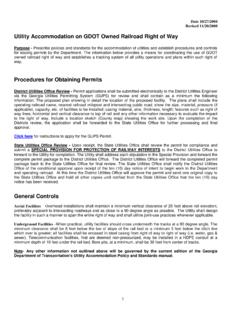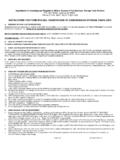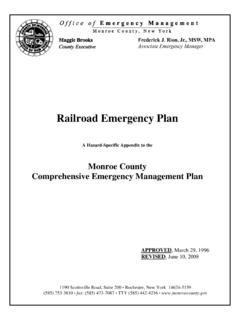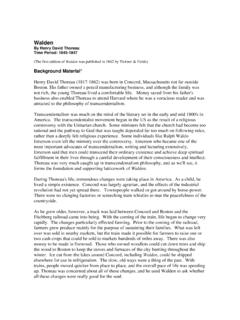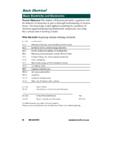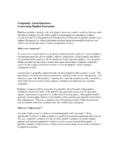Transcription of Underground Mining Transportation Systems
1 UNESCO EOLSSSAMPLE CHAPTERSCIVIL ENGINEERING Vol. II - Underground Mining Transportation Systems - K. Matsui Encyclopedia of Life Support Systems (EOLSS) Underground Mining Transportation Systems K. Matsui Kyushu University, Fukuoka, Japan Keywords: Underground , transport, shaft, drift, longwall, belt conveyor, rail, trackless, winder Contents 1. Introduction 2. From Surface to Underground /Vice Versa Shafts Cage Skips Inclined Shafts or Inclined Drifts 3. Underground Transport for Materials and Equipment Track system /Rail-mounted Systems Trackless Systems Combined Systems Longwall Equipment Transport 4. Ore/Coal Transport Metalliferous Mines Coal Mines Heading Face Area Longwall Face Area Belt Conveyors Surge Control for Belt Conveyor Haulage Rail Systems Shaft Winding 5.
2 Personnel Transport Access to Underground Personnel Transport in Working Sites Trackless Personnel Transport Systems Track-mounted Personnel Transport Systems Belt Conveyor Systems Other Systems Acknowledgements Glossary Bibliography Biographical Sketch Summary Underground mines have changed their operation Systems in accordance with the evolution of equipment, the system and method of Mining . Transport is also of critical importance in Underground mines as is the Mining operation itself. The Underground transport system of ores, materials, equipment and persons has been developed from UNESCO EOLSSSAMPLE CHAPTERSCIVIL ENGINEERING Vol.
3 II - Underground Mining Transportation Systems - K. Matsui Encyclopedia of Life Support Systems (EOLSS) primitive hand operation to the mechanized and automated operation through the rapid progress of technology in production equipment and methods of extraction, leading to higher productivity and production. The transport system must be designed, considering the many other elements of the Mining operation, and we must take into account the number of possible steps from the extraction site (stope/face) to the shaft or ramp portal. The total system has been established - as a combination of various types of equipment - such that it is most applicable to the ore deposits being mined, the Mining methods employed and the mine layout.
4 1. Introduction Transport developments followed two distinct routes in each of the major functions, namely the movement of ore/coal, persons, materials and equipment. Ore/coal transport has either been by locomotive-hauled mine cars, belt conveyors or rubber-tired trucks. The transport of persons, materials and equipment has either been by rail-mounted track Systems or trackless Systems /movable vehicles. Each system described above is still widely popular for those various specific reasons. The considerations of transport Systems for ore/coal, persons, materials and equipment are major factors in the decision to use drifts and/or shafts for a mine.
5 2. From Surface to Underground /Vice Versa Considering transport Systems from the surface to Underground , mines may be classified into two basic categories; shallow mines with roadways of level or shallow gradients, and deep mines with vertical shafts or long inclined drifts. Deep mines require some form of specific transport system between the surface and the Underground level. On the other hand, shallow mines generally require a direct and simple transport system . There has been considerable and continuing debate on the use of shafts or inclined drifts in deep mines. The advantages of drift transport Systems over shaft Systems are as follows: 1.
6 The lowering and raising of all materials and equipment without dismantling and reassembly. 2. The compatible use of drift for persons and materials transport and ore/coal haulage by conveyor without any operational interference of one with the other. Shafts There are many mines using a shaft for persons, materials and equipment transport. The main advantage of a shaft for personnel transport compared to a drift is in the traveling time. The maximum load that can be carried in each shaft varies depending on the installation. Transported materials are generally palletized, railed into the cage and lowered inside the UNESCO EOLSSSAMPLE CHAPTERSCIVIL ENGINEERING Vol.
7 II - Underground Mining Transportation Systems - K. Matsui Encyclopedia of Life Support Systems (EOLSS) cage. Pipes and long materials may be slung either in or below the cage. Large machines must be partially dismantled, loaded, lowered and then reassembled Underground . Personnel vehicles such as rubber-tired vehicles are self-trammed into the cage and then lowered with people on board. The winders used for shaft transport are drum type and multi-rope friction type. The winding operations are done automatically or manually. Figure 1 shows a vertical shaft at Ikeshima Colliery, Japan. The winder is a multi-rope friction type and automatically operated.
8 Figure 1: Vertical shaft at Ikeshima Colliery Cage The prime function of a cage is the transport of persons and materials to and from UNESCO EOLSSSAMPLE CHAPTERSCIVIL ENGINEERING Vol. II - Underground Mining Transportation Systems - K. Matsui Encyclopedia of Life Support Systems (EOLSS) Underground . In high production mines, the handling of large pieces of equipment is important. A cage used for lowering and raising persons must be covered and equipped with gates for safety. The size and number of decks on the cage depends on the size of the operation and the equipment being handled. Cages vary from a single deck up to a triple deck.
9 Figure 2 shows the triple deck cage system used in Ikeshima Colliery, capable of carrying a maximum of 30 people per deck. Figure 2: Triple deck cage The cage is normally equipped with safety devices for protection in the event of rope failure. These safety devices are designed to operate on the timber guides. Skips Skips are shaft conveyors for hoisting ore/coal or waste from the Underground . The most significant feature is the method by which ore/coal is discharged from the skip. Skips now in use are almost always the bottom-dump design. Skip loading is often automated in conjunction with automated slumping and automated ore/coal hoisting Systems .
10 Loading Systems that involve measurement by load or by volume can be used. Volumetric Systems are used primarily for use of relatively uniform density and where an occasional waste rock is of lesser density than the ore. Any condition where ore density variation can cause overload on the hoist, necessitates the use of measurement by the load system . Volume measurement is by cartridge or pocket with switching or gate control. Measurement by load utilizes a load cell device supporting the pocket plus the ore. This allows constant loads irrespective of density with limit devices for overfill. UNESCO EOLSSSAMPLE CHAPTERSCIVIL ENGINEERING Vol.










